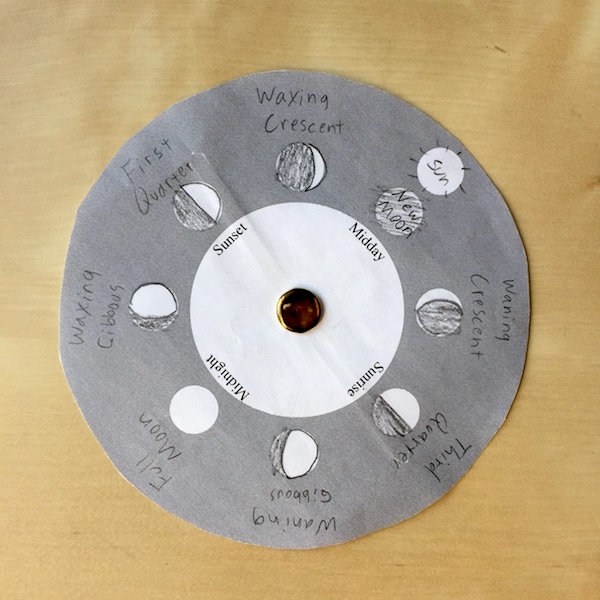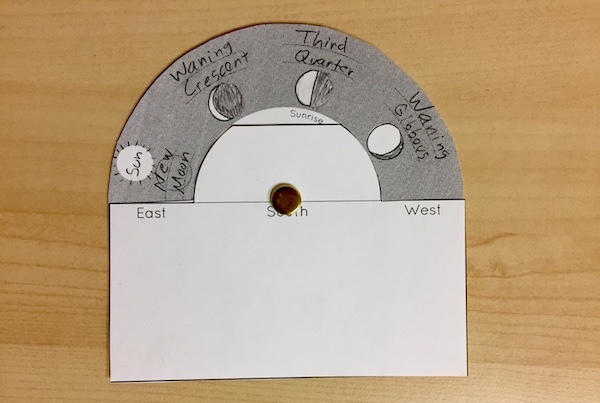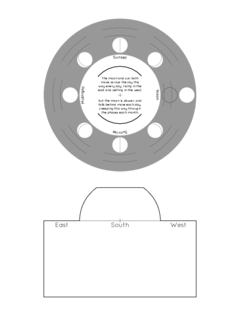A Lunar Phase Dial
A paper “phase clock” for kids to label, cut out, assemble, and use to predict moon phases and rise times.
As most of us are probably aware, the moon’s phases do not occur at random. From the “new moon”, the moon grows through the “waxing” phases until it is “full,” then it shrinks through the “waning” phases back down to “new,” and then it starts the same cycle all over again. The phases go by in a never-ending repeating cycle. But what about where the moon is in the sky? What about the time of day? You might not have noticed that the pattern of phases is firmly linked to its position and its motion across the sky. And if you understand the pattern, then you can figure out what direction you are facing every time you see the moon, no matter what phase it is or what time of day. If you want to hunt for a hard-to-find moon in the daytime sky, you can figure out where and when you need to look, as long as you know what phase it is. And so on.
If you pay attention to the moon as you wander through life, you may notice that you sometimes see the moon low over the sunset, and it is always a beautiful sliver when it is there. With my students, I sometimes called this the “sunset moon.” The official name is “waxing crescent.” Whenever you see the moon low over the sunrise, it will also be beautiful crescent, but tilted the other way. This is the “sunrise moon” or the “waning crescent.” The full moon is the “opposite moon” — it is always on the other side of the sky from the sun. (It must also be on the other side of us in space, since we see them on opposite sides of us.) This “opposite moon” rises in the east just as the sun sets in the west, it sets in the west just as the sun rises in the east, and it can never be in the sky at the same time as the sun. (This is why we tend to think of the moon as a nighttime object. In other phases, the moon could be anywhere in the sky at any time of day, but the large, bright, full moon is only in the nighttime sky. The full moon can never share the sky with the sun, even though the other phases can.) Similarly, the “gibbous” phases are always far from the sun in the sky, and the “quarter” phases are always a quarter-turn from the sun in the sky.
But that's a lot of detail to remember. Is there a way to capture the entire lunar phase cycle in a simple picture? Can we make a small hand-held model of the lunar cycle that helps us to remember how the phase of the moon, the position of the moon in the sky, and the time of day are all related?
The Cycle of Phases in a Picture
The next time you see a beautiful crescent moon over the sunset, make sure to keep watching it, and see what happens day by day for the next week. (If you want to know when to start looking, find out when the new moon occurs, and start looking over the sunset about two days after the new moon. Or try to find it one day after the new moon if you want a challenge.) What happens to the “sunset moon” as the days go by? If you look for it before the sun sets, during the daytime, can you find the moon? (Trying to find a thin crescent moon in the daytime can be a fun challenge.) How long does it take for the moon to go from new to full? After the full moon, you need to start looking for the moon in the morning sky instead of the evening sky. How long does that take?
As an important part of one's science education, I think everyone should observe the progression of the moon through its phases, in their own sky and with their own eyes, through at least one cycle. When I was a teacher, in order to record and summarize our observations, I gave my students a handout to use as a sort of “journal.” It had two pictures of a horizon, stretching from the eastern horizon on the left to the western horizon on the right, and representing the view of a person facing south and observing the sky. (I live and I taught in the Northern Hemisphere. If you live in the Southern Hemisphere, you would want to face north instead of facing south, with west on your left and east on your right.) On one of these pictures, we drew the sun setting in the west, and we draw a series of moon phases, growing from the “sunset moon” through first quarter to full, as the moon creeps westward away from the sun, and ending with the full moon rising in the east as the sun sets in the west. On the other horizon, we switched our attention to morning, we drew the sun rising in the east, and we drew the reverse sequence of waning moon phases as the moon crept closer to the sun across the morning sky.
Phases and Angles
This journaling activity helps to make clear that there is a direct connection between the phase of the moon, and how far away it is from the sun in the sky. When the moon is close to the sun, it is a crescent. When it is far from the sun, it is a larger gibbous phase or a full moon. If you have studied a little geometry, maybe you'll notice how the phases of the moon go with the angles. Point to the sun with one arm, and point to the moon with the other, and notice the angle that your arms make: The moon is always crescent when it is at an acute angle from the sun in the sky, it is always a quarter when it is a quarter-turn or a right angle from the sun in the sky, and it is always gibbous when it is an obtuse angle from the sun in the sky. If we want to include the new moon and the full moon by giving names to those angles, we can say that the new moon has an angle of zero, or nearly so, and the full moon is nearly a “straight angle,” or 180°.
What if we wanted to make a single picture, a cartoon of sorts, showing the entire cycle rather than two halves? In my classes, it took very few hints, if any at all, to get a student to suggest turning one of the pictures upside-down, and then putting the two pictures together. If you do this, you get a circular picture something like this:

This represents the entire cycle of phases in a single ring, and if you draw or imagine the angle between the sun and any moon phase on the ring, that will be the angle between the sun and the moon in the sky, when the moon has that phase. We have made a simple picture the summarizes the relationship between the moon phases and the sun in the sky. It's a crude sort of “scientific model.” What can you do with a model of the lunar phase cycle? For one thing, if you know what the phase is now, you easily tell how long it will be until the next full moon, or any other phase you want. If you were paying attention to how long the moon takes to go from one phase to another when you were filling in your journal, you will have noticed that the moon takes about two weeks, or a fortnight, to go from new to full, and another fortnight to go from full back to new again. Each quarter-turn takes about a week, and the whole cycle takes about a moonth. You can figure out (approximately) what phase the moon will be at any time in the future, or at any time in the past, simply by counting phases counterclockwise or clockwise, one quarter-turn for each week, and one full turn for each month.
Representing the Horizon and the Sky
What about figuring out the time of day or the position in the sky? Can we make a complete “lunar phase calculator”? For this, we need to add something to our “model” to represent our horizon. We need to add a horizon cover. Assuming you live in the northern hemisphere, you can cover the bottom half of the dial, and the upper half will represent the path across the sky along which the sun and moon travel, as seen by someone facing south. The left side of the dial will show the sun or the moon rising in the east, the top of the dial will represent them high in the southern sky, and the right side will represent them setting in the west. By turning the dial, you “model” how the sun and the moon move across the sky. If you want to make it represent any time of day, you simply turn the dial so that the sun is in the appropriate part of the sky. For example, if you turn the dial so that the sun is touching the horizon on the right (west), representing sunset, the phases on the dial will look just like the “evening moon” figure in our journal, and it will show the positions in the sky of all the moon phases that you might see at the time of sunset. If you turn the dial so that the sun is on the left, then it will represent sunrise, it should look like the “morning moon” figure in the journal, and it will show the positions in the sky of all the moon phases that you can see near the time of sunrise. But you can also make it show any other time of day just by turning the dial so that the sun is in the right part of the sky for that time of day. You can make your dial show the phases that you might see at noon by placing the sun at the top of the dial. You can make your dial show midnight by placing the sun at the bottom, behind the horizon cover. With a dial like this, you have a “phase clock” or “phase calendar,” and you can use it to show where the moon will be in the sky at any time of day for any given phase.

Incidentally, is the moon up more often in the daytime, or is it up more often at night? We often think of the sun as the “ruler of the day,” and the moon as the “ruler of the night,” but is that really correct? Well, yes and no. The moon is actually above the horizon in the daytime just as often as it is up at night. But there’s a reason we think of the moon as being a nighttime thing. Turn the dial to represent noon, and notice which phases are visible at that time. Do the same for midnight. Compare the phases that you can see at night with the phases that you can see during the daytime. Do you see a reason why we might think of the moon as a nighttime thing, even though it is up in the daytime just as often?
Making a Lunar Phase Dial
Printing and Filling in the Template
If you want to make your own dial, start by downloading the template using the link below, and printing it onto card stock. Normal typing paper will also work, but it will make a flimsy, floppy dial. Card stock will be more durable and will have more heft. Shade in the moon phases, and label the sun and the phases. When shading, remember that the side of the moon facing the sun is always bright, and the side facing away is always dark. As far as I can tell, “third quarter” and “last quarter” are equally common names, but I chose to go with “third quarter.” Personally, I like the names “new crescent” and “old crescent” a little better than “waxing crescent” and “waning crescent,” but the latter names are far more standard.

Assembling the Dial
To assemble the dial, cut out both pieces around their outlines. (If you want to try some practice problems involving thinking ahead to upcoming phases, you might want to stop here before fastening the cover over your dial. See the “predicting phases” problems below.) Now place the cover over the disk portion with the centers aligned, and press a 2″ brass fastener through the center of both pieces. Fold the legs flat against the back of the dial and flatten them as much as possible. I find that if you turn the dial right-side-up and press against the brass knob with your thumb, or lay a weight on top of the dial, it helps to make the brass legs on the back side very smooth and flat. Finally, tape the legs of the brass fastener against the back of the dial. The assembled dial looks like this:


If you have followed the instructions to this point, you will now have an assembled dial, but the dial will be stuck and not turn. If I had made the hump in the middle of the dial a little smaller, it would have been possible to reach the center mark with a hand-held hole punch, and to punch a hole in which the brass fastener could turn. As it is, if you gently turn the dial by hand until it spins freely, it will ream out its own hole. That’s not the most elegant way to do things, but it works perfectly well.
Which Way Does the Moon Go?
You may have noticed that I omitted arrowheads on the blank version of the dial. I wanted to spend some time clarifying “which way things go” with my students, and then to make them add their own arrowheads once we were clear on the difference between the clockwise and the counter-clockwise motions.
If you watch the sun or the moon for a few hours and compare their positions in the sky at different times of day, you will observe that they both go clockwise. (This assumes you live in the Northern Hemisphere and face south. If you live in the Southern Hemisphere, you will face north and watch them pass counter-clockwise across your northern sky.) In other words, in the Northern Hemisphere, both the sun and the moon rise in the east, pass from east to west across the southern sky, and set in the west. The both pass along roughly the same path, and they both go around about once a day. It is as if they are racing each other from east to west across the sky.
But if you watch the moon at the same time each day for many days, you will notice that it goes backwards. Compared to the sun, the moon goes counterclockwise. If the sun and moon are racing east to west across the sky, then the moon is gradually falling behind the sun. It falls behind a little bit more each day, it creeps gradually from west to east as the days and weeks go by and it gets passed or “lapped” by the sun once a month in their race around the racetrack.
On the phase dial (assuming you live in the Northern Hemisphere), you mimic or model the daily motion by turning your dial clockwise. As you turn the dial slowly clockwise, it will show the sun and moon rising on the left (i.e. in the east), passing in an arc across the top (i.e. high in the southern sky), and setting on the right (i.e. in the west). On the dial, you mimic or model the monthly motion of the moon through the phases simply by shifting your attention counterclockwise through the phases. To follow the moon through its phases, you have to go counterclockwise around the dial.
With sufficiently mature students, maybe 3rd or 4th grade and above, and depending on circumstances, I might spend a little time exploring the causes for these visible motions. Everything in the sky rotates from east to west about once a day. One explanation for this might be that everything in outer space is really standing still, but we are spinning the other way, from west to east. It would be like looking out from a merry-go-round and watching the world go by as we turn. But if this is so … if the apparent motion in the sky is really due to the earth spinning from west to east, and everything only looks like it's moving east to west … then what about the much slower creeping motion of the moon? That slow west-to-east motion of the moon compared to the sun, once around each month — that's a real circular motion of the moon around us. That's the monthly orbit of the moon. When you watch the crescent moon rise higher over the sunset day by day, you are watching the moon orbit slowly from west to east around us.